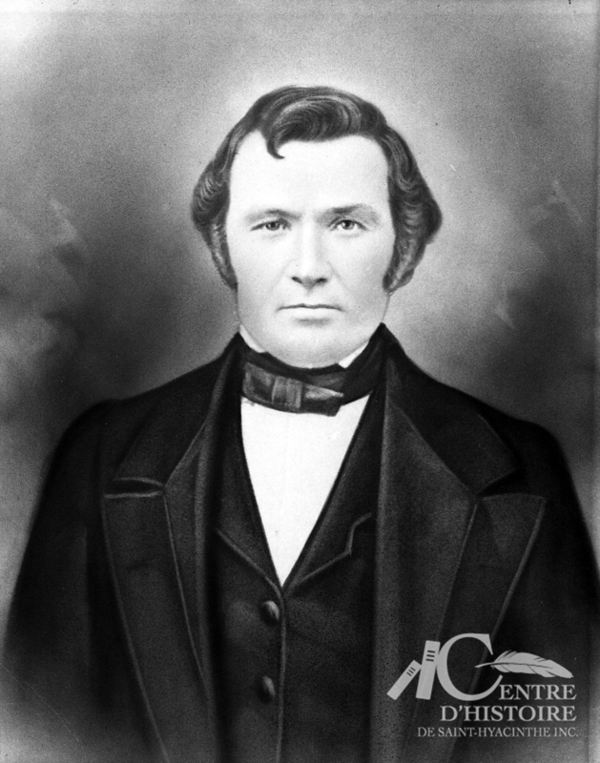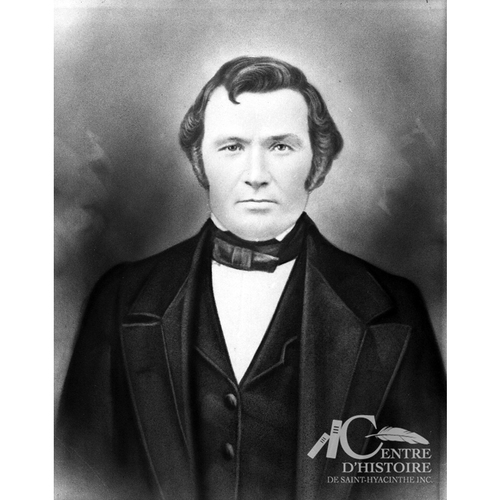As part of the funding agreement between the Dictionary of Canadian Biography and the Canadian Museum of History, we invite readers to take part in a short survey.

Source: Link
CASAVANT, JOSEPH, organ builder; b. 23 Jan. 1807 in the parish of La Présentation-de-la-Sainte-Vierge (La Présentation), Lower Canada, son of Dominique Casavant, a farmer, and Marie-Desanges Codère; d. 9 March 1874 in Saint-Hyacinthe, Quebec.
Joseph Casavant first became a blacksmith. He sometimes liked to abandon the music of the anvil to listen to the only piano in his village, which was in the house of Jean Dessaulles*, seigneur of Saint-Hyacinthe. Of an inquiring and enterprising spirit, Casavant gave up the trade of blacksmith at the age of 27 and went to Sainte-Thérèse, with $16 in his pocket, to study under the direction of the parish priest Charles-Joseph Ducharme*, who had just founded a classical college. Although he lived in the village, Casavant studied at the presbytery. He had lost nothing of his taste for music, and he spent hours “drawing sounds from an old piano and from a violin of his own contriving.” His natural ingeniousness led Ducharme to advise his pupil to study the mechanism of the organ. The parish priest lent him the works of Dom François de Bédos de Celles, one of which was an enormous treatise, L’art du facteur d’orgues; through the latter, Casavant obtained his initiation into manufacturing instruments and learned his new trade. Soon success came his way, for he managed to finish a partially built organ which was in the presbytery and to give it life. The result was that by 1840 he was able to undertake, in his workshop at Saint-Hyacinthe, the building of an organ for the parish church of Saint-Martin on Île Jésus.
In 1843 he offered for sale another instrument, with 12 stops, and in 1844 the parish council of Saint-Jean (Saint-Jean-sur-Richelieu) decided that it wanted to have a Casavant organ. It was probably around 1848 that he partnered with Augustin Lavallée, father of Calixa Lavallée* and previously a blacksmith like himself. Casavant’s growing fame soon brought him an order for an organ for the church at Bytown (Ottawa), and he went to live there temporarily. On 19 June 1850 he married Marie-Olive Sicard in Saint-Hyacinthe. Two sons were born of this marriage: Claver* on 16 Sept. 1855 and Samuel on 5 April 1859.
Meanwhile, Joseph was receiving more and more orders, and producing an increasing number of fine instruments; for example, those for Kingston (1854), Longueuil (1860), and Saint-Jérôme (1861). In 1866 Joseph, who, following the custom of the time, considered himself old at an early age, made over his establishment to his assistant, Eusèbe Brodeur. But he was mindful of his sons’ future, and he came to an understanding with the new owner so that the latter would take in Claver and Samuel as soon as they were old enough to learn the trade.
History shows that he was right to steer his sons towards organ building. Indeed, they became masters of their craft, and their reputation spread throughout America and even to Europe. If the name Casavant still inspires respect, it is surely because of the company started by the brothers Samuel and Claver. But if they have acquired fame, it is because Joseph, their father, was able to transmit to them creative genius and the love of their art. We can only regret that nothing remains today of those mid-19th-century instruments built by a blacksmith with music in his soul.
Cyclopædia of Can. biog. (Rose, 1888), 590. Encyclopedia of Canada, II, 10. Émile Dubois, Le petit séminaire de Sainte-Thérèse, 1825–1925 (Montréal, 1925), 53–54. F[rère] Élie [J.-S.-Z. Phaneuf], La famille Casavant (Montréal, 1914). Gérard Morisset, Coup d’œil sur les arts en Nouvelle-France (Québec, 1941), 116, 118–19. Léonidas Bachand, “L’orgue et les frères Casavant,” La Vie canadienne (Montréal), I (1929), 588–92. Antoine Bouchard, “Casavant Frères; facteurs d’orgues depuis un siècle,” Forces (Montréal), no.2 (1967), 29–34. Victor Morin, “L’orgue, ce merveilleux instrument,” Les conférences du club musical et littéraire de Montréal (Montréal), 1re sér., I (1941–42), 93–105.
Revisions based on:
Bibliothèque et Arch. Nationales du Québec, Centre d’arch. du Vieux-Montréal, CE602-S1, 11 mars 1874; CE602-S3, 24 janv. 1807; CE602-S5, 19 juin 1850. [J.-]E. Lapierre, Calixa Lavallée, musicien national du Canada (3e éd., Montréal et Paris, 1966), 22–23.
Cite This Article
Antoine Bouchard, “CASAVANT, JOSEPH,” in Dictionary of Canadian Biography, vol. 10, University of Toronto/Université Laval, 2003–, accessed March 28, 2025, https://www.biographi.ca/en/bio/casavant_joseph_10E.html.
The citation above shows the format for footnotes and endnotes according to the Chicago manual of style (16th edition). Information to be used in other citation formats:
| Permalink: | https://www.biographi.ca/en/bio/casavant_joseph_10E.html |
| Author of Article: | Antoine Bouchard |
| Title of Article: | CASAVANT, JOSEPH |
| Publication Name: | Dictionary of Canadian Biography, vol. 10 |
| Publisher: | University of Toronto/Université Laval |
| Year of publication: | 1972 |
| Year of revision: | 2022 |
| Access Date: | March 28, 2025 |



